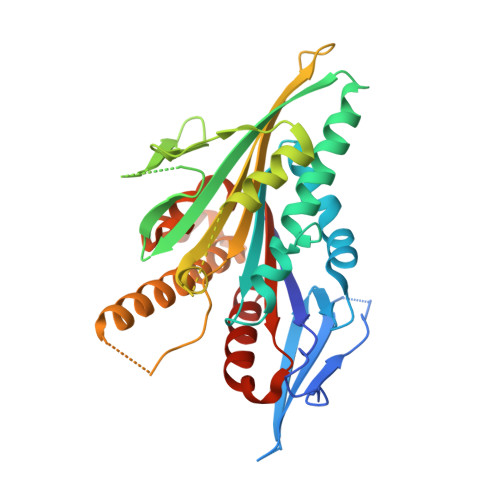Crystal structure of the Kar3-like kinesin motor domain from the filamentous fungus Ashbya gossypii.
Duan, D., Hnatchuk, D.J., Brenner, J., Davis, D., Allingham, J.S.(2012) Proteins 80: 1016-1027
- PubMed: 22493778
- DOI: https://doi.org/10.1002/prot.24004
- Primary Citation of Related Structures:
3T0Q - PubMed Abstract:
Kar3 kinesins are microtubule (MT) minus-end-directed motors with pleiotropic functions in mitotic spindle formation and nuclear movement in budding and fission yeasts. A Kar3-like kinesin is also expressed by the filamentous fungus Ashbya gossypi, which exhibits different nuclear movement challenges from its yeast relatives. Presented here is a 2.35 Å crystal structure and enzymatic analysis of the AgKar3 motor domain (AgKar3MD). Compared to the previously published Saccharomyces cerevisiae Kar3MD structure (ScKar3MD), AgKar3MD displays differences in the conformation of some of its nucleotide-binding motifs and peripheral elements. Unlike ScKar3MD, the salt bridge between Switch I and Switch II in AgKar3MD is broken. Most of the Switch I, and the adjoining region of helix α3, are also disordered instead of bending into the active site cleft as is observed in ScKar3MD. These aspects of AgKar3MD are highly reminiscent of the ScKar3 R598A mutant that disrupts the Switch I-Switch II salt bridge and impairs MT-stimulated ATPase activity of the motor. Subtle differences in the disposition of secondary structure elements in the small lobe (β1a, β1b, and β1c) at the edge of the MD are also apparent even though it contains approximately the same number of residues as ScKar3. These differences may reflect the unique enzymatic properties we measured for this motor, which include a lower MT-stimulated ATPase rate relative to ScKar3, or they could relate to its interactions with different regulatory companion proteins than its budding yeast counterpart.
Organizational Affiliation:
Department of Biochemistry, Queen’s University, Kingston, Ontario, Canada.

















